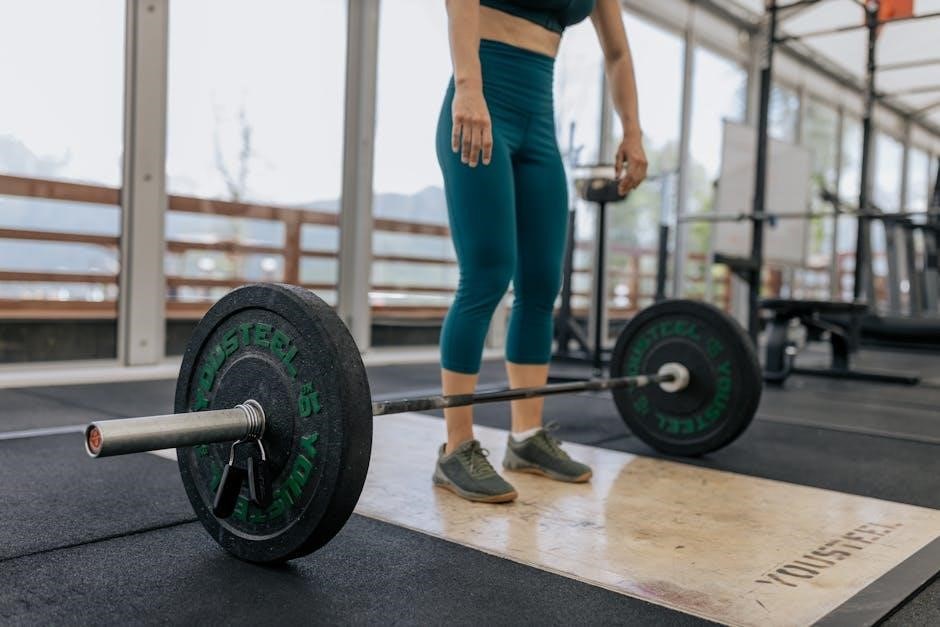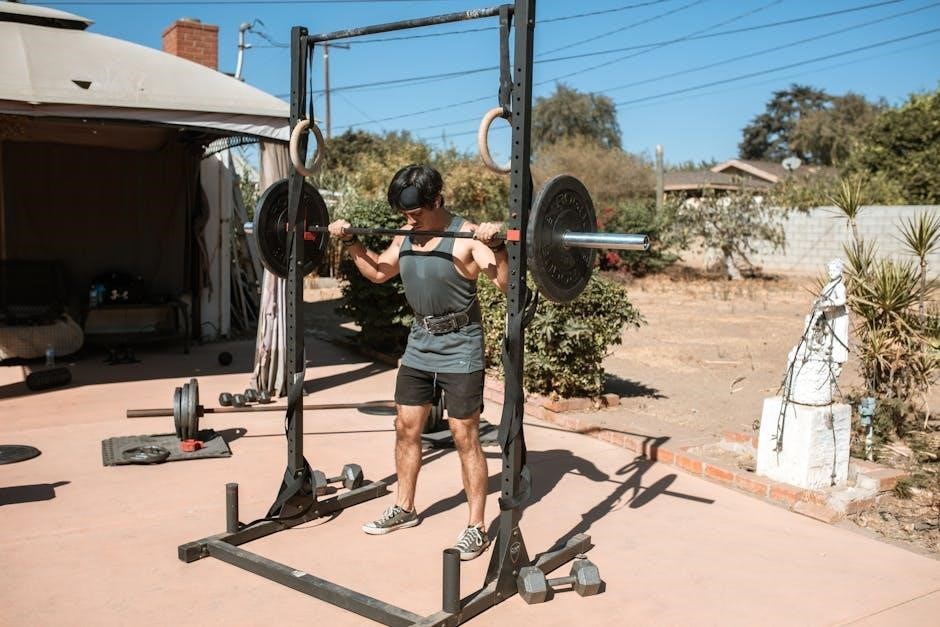Powerlifting routines are structured plans designed to enhance strength and technique in the squat, bench press, and deadlift. These routines, often available as downloadable PDFs, provide detailed workout schedules and progression strategies for lifters of all levels, from beginners to experienced athletes.
Overview of Powerlifting
Powerlifting focuses on three core lifts: the squat, bench press, and deadlift. It is a strength sport that emphasizes progressive overload and technique mastery. Unlike bodybuilding or CrossFit, powerlifting centers on maximizing one-rep max in these specific exercises. Lifters typically follow structured routines, often detailed in PDF guides, to build strength systematically. The sport requires consistency, patience, and attention to recovery to achieve long-term gains. Whether for competition or personal growth, powerlifting offers a clear path to measurable progress in strength and physical performance.
Importance of a Structured Routine
A structured powerlifting routine is essential for consistent progress and avoiding plateaus. It ensures balanced training, recovery, and progressive overload. Without a clear plan, lifters risk overtraining or undertraining, which can hinder gains. A well-designed routine, often detailed in PDF guides, provides clarity and direction, helping athletes stay focused on their goals. By following a structured plan, lifters can optimize their time, track progress, and adjust as needed, ensuring steady improvements in strength and technique over time.

Understanding the Basics of Powerlifting
Powerlifting focuses on three core lifts: squat, bench press, and deadlift. It emphasizes strength, technique, and progression, making it accessible to lifters of all levels.
Key Concepts for Beginners
For those new to powerlifting, understanding proper form and technique is essential. Start with foundational lifts like the squat, bench press, and deadlift, focusing on controlled movements. Progression is key—begin with manageable weights and gradually increase loads. Consistency and patience are crucial, as strength gains take time. Setting realistic goals helps track progress and stay motivated. A well-structured routine, such as those found in powerlifting routine PDFs, provides guidance and ensures a safe, effective journey into the sport.
Setting Realistic Goals
Setting realistic goals is crucial for success in powerlifting. Begin by assessing your current strength levels and defining clear, achievable targets. Break your goals into short-term and long-term milestones, ensuring they align with your training capacity; Use a powerlifting routine PDF to structure your progress and track improvements. Stay motivated by celebrating small victories, like increasing your one-rep max or mastering proper form. Balance ambition with realism to avoid discouragement and maintain consistent progress. A well-defined goal framework keeps you focused and driven throughout your lifting journey.

Types of Powerlifting Routines
Powerlifting routines vary, including 5-day split programs and 12-week structured plans. These routines, often available as PDF guides, cater to different goals, experience levels, and training preferences.
5-Day Powerlifting Split Program
A 5-day powerlifting split program is an intense routine designed for intermediate to advanced lifters. It focuses on training each major lift multiple times a week, with dedicated days for the squat, bench press, and deadlift. Auxiliary exercises are included to build supporting muscle groups. This program is typically structured to allow for optimal recovery and progressive overload. Many 5-day programs are available as downloadable PDFs, offering detailed workout schedules and progression strategies to help lifters achieve their strength goals effectively.
12-Week Powerlifting Program
A 12-week powerlifting program is a comprehensive training plan designed to maximize strength gains in the squat, bench press, and deadlift. It typically incorporates periodization, with phases focusing on hypertrophy, strength, and peaking. The program often includes downloadable PDF guides, offering detailed workout schedules, set/reps schemes, and nutritional advice. This structured approach ensures lifters build a strong foundation and peak just in time for competition or personal record attempts, making it a popular choice among serious powerlifters.

Training Frequency and Volume
Training frequency and volume are crucial in powerlifting. Balancing intensity with recovery ensures progress. Adjusting frequency based on experience and goals maximizes results effectively.
Optimal Training Frequency
Optimal training frequency in powerlifting involves balancing intensity with recovery. Most lifters benefit from training each major lift (squat, bench, deadlift) 3-4 times per week. Allow 48-72 hours of recovery between sessions targeting the same muscle groups. Overtraining can lead to decreased performance and injury. Adjust frequency based on experience, goals, and current workload to ensure consistent progress and long-term sustainability.
Managing Training Volume
Training volume in powerlifting refers to the total amount of work performed. It’s crucial to balance volume with recovery to avoid injury and optimize progress. Novice lifters should start with lower volume, focusing on technique and consistency. As lifters gain experience, volume can be gradually increased. Intermediate to advanced lifters often handle higher volumes, incorporating variations of the core lifts. Tracking progress and adjusting volume based on performance and recovery is essential. Periodization, or varying volume over specific phases, helps prevent plateaus and ensures long-term progression. Proper volume management supports strength gains while maintaining overall health.

Core Lifts in Powerlifting
The core lifts in powerlifting are the squat, bench press, and deadlift. These exercises form the foundation of any effective powerlifting routine, targeting major muscle groups and improving overall strength.
Squat Technique and Tips
The squat is a fundamental lift in powerlifting, requiring precise technique to maximize strength and minimize injury risk. Start with a shoulder-width stance, toes slightly outward. Engage your core, maintain a neutral spine, and lower the bar to the bottom of your range of motion. Ensure your knees track over your toes and avoid letting them cave inward. Use a full grip on the barbell for control and stability. Practice paused squats to improve strength at the bottom. Focus on progressive overload by gradually increasing weight while maintaining proper form. Recover adequately between sets to optimize performance.
Bench Press Optimization
Optimizing your bench press involves proper technique and consistent practice. Start with a shoulder-width grip, squeezing the bar tightly to engage your upper back. Lower the bar to your chest with control, ensuring full range of motion. Press upward explosively but maintain control throughout. Use leg drive to generate power and maintain core engagement. Avoid hitching or uneven movement. Incorporate variations like incline or paused bench presses to target weak points. Focus on progressive overload and recovery to enhance strength gains. Consistency and proper form are key to mastering this lift.
Deadlift Strategy and Safety
The deadlift is a foundational powerlifting exercise targeting multiple muscle groups. Start with a shoulder-width stance, toes pointing slightly outward. Keep the bar close to your shins and hinge at the hips, maintaining a neutral spine. Engage your core and pull the bar upward with a consistent, controlled motion. Avoid rounding your back or using excessive momentum. Focus on progressive overload to build strength safely. Use lifting straps for heavy weights and ensure proper recovery to prevent injury. Consistent practice and attention to form are crucial for mastering the deadlift effectively.

Progressive Overload in Training
Progressive overload is essential for continuous improvement in powerlifting. It involves gradually increasing weight, reps, or intensity to challenge muscles and promote strength gains over time consistently.
Strategies for Continuous Improvement
Continuous improvement in powerlifting requires a combination of progressive overload, periodization, and careful tracking. Start with a well-structured PDF routine that outlines weekly progression. Gradually increase weights or reps over time to avoid plateaus. Incorporate deload weeks to allow recovery and prevent overtraining. Regularly assess your one-rep max to measure progress and adjust your program accordingly. Consistency and patience are key, as strength gains develop over months. Customize your approach based on performance and goals to ensure sustained improvement.
Periodization and Wave Periods
Periodization involves structuring training into specific phases to maximize strength gains and peak performance. A common approach is dividing the program into blocks, such as hypertrophy, strength, and deload phases. Wave periods alternate between high-intensity and high-volume training to optimize recovery and progress. This method prevents overtraining and ensures consistent improvement. By incorporating deload weeks, lifters can maintain long-term sustainability in their powerlifting journey. Properly designed periodization strategies, often detailed in PDF routines, help athletes achieve their goals without burnout.

Nutrition for Powerlifters
A well-structured diet is crucial for powerlifting success. Focus on balancing macronutrients, maintaining hydration, and timing meals to fuel workouts. Supplementation can enhance performance and recovery, as detailed in PDF guides.
Meal Planning and Macronutrients
Effective meal planning for powerlifters involves balancing macronutrients to support strength and recovery. Typically, a diet high in protein (1.6-2.2g per kg of body weight) is recommended to repair muscles. Carbohydrates provide energy for intense workouts, while fats support hormonal health. Many PDF guides offer sample meal plans tailored to powerlifters, ensuring proper calorie intake and nutrient distribution to optimize performance and muscle growth without unnecessary fat gain.
Supplementation for Performance
Supplementation plays a key role in enhancing powerlifting performance by addressing nutritional gaps and boosting recovery. Popular supplements include protein powder for muscle repair, creatine to increase strength and endurance, and beta-alanine to delay fatigue. Additionally, fish oil supports joint health, while caffeine can improve focus during intense workouts. Many PDF guides outline optimal supplement routines, ensuring lifters maximize their training benefits without overcomplicating their regimen. These supplements, when combined with proper nutrition, help powerlifters achieve peak performance and faster recovery times.

Recovery Techniques
Recovery is crucial for powerlifters, involving adequate rest, sleep, and nutrition. Active recovery methods like stretching and foam rolling enhance muscle repair, ensuring optimal performance in training and competition.
Rest and Sleep Importance
Rest and sleep are critical for muscle recovery and strength gains in powerlifting. Adequate rest allows muscles to repair and rebuild, while quality sleep enhances hormonal balance and physical rejuvenation. Ensuring 7-9 hours of sleep nightly supports recovery, with rest days preventing overtraining and injury. Prioritizing sleep and rest optimizes performance, helping lifters achieve their goals effectively.
Active Recovery Methods
Active recovery involves low-intensity activities to promote blood flow and reduce muscle soreness without overstraining. Techniques include light cardio, stretching, yoga, and foam rolling. These methods enhance recovery, improve mobility, and prevent stiffness. Incorporating activities like cycling or swimming on rest days supports overall training consistency. Active recovery complements rest and sleep, ensuring lifters maintain performance and prevent injuries. Regularly practicing these methods is essential for sustained progress in powerlifting routines.

Accessory Work and Conditioning
Accessory exercises and conditioning support muscle balance, strength, and longevity. They enhance recovery, prevent injuries, and improve overall performance in powerlifting routines, ensuring sustained progress and peak form.
Effective Accessory Exercises
Accessory exercises are crucial for targeting muscle imbalances and enhancing overall strength. Pull-ups, dumbbell presses, and lunges are excellent for building complementary strength. These exercises improve muscle balance, reducing injury risk and boosting recovery. Incorporate them 2-3 times weekly, focusing on controlled movements and progressive overload. Accessory work also enhances joint stability and mobility, ensuring optimal performance in the squat, bench, and deadlift. By addressing weaknesses, lifters can achieve a more robust foundation for their powerlifting routine, leading to better overall results and longevity in training.
Conditioning for Enhanced Performance
Conditioning plays a vital role in powerlifting by improving muscular endurance and recovery. Activities like rowing, cycling, or swimming can be incorporated 2-3 times weekly. These exercises enhance cardiovascular health and increase work capacity without interfering with strength training. Proper conditioning ensures lifters can handle higher training volumes and recover faster between sessions. It also reduces the risk of overtraining and prevents plateaus. A well-structured conditioning program complements the powerlifting routine, leading to enhanced overall performance and longevity in the sport.
Tracking Progress and Adjustments
Monitoring strength gains and adjusting routines is crucial for optimal results. Use spreadsheets or PDF trackers to log lifts and progress. Regularly assess performance to ensure continued improvement and avoid plateaus.
Monitoring Strength Gains
Tracking strength gains is essential for evaluating progress in your powerlifting journey. Use detailed spreadsheets or PDF templates to log lifts, weights, and reps. Regularly assess improvements in your one-rep max and overall performance. Set realistic goals and adjust your routine based on observed gains. This data-driven approach ensures continuous improvement and helps prevent plateaus. By monitoring progress, you can refine your training and nutrition strategies to optimize results. Consistent tracking also aids in identifying areas for further development, ensuring a well-rounded and effective powerlifting program.
Adjusting the Routine as Needed
As you progress, it’s crucial to adapt your powerlifting routine based on performance and recovery. Monitor gains and adjust weights, reps, or exercises to avoid plateaus. Incorporate deload weeks to allow recovery and prevent overtraining. Fine-tune your program by increasing intensity or volume gradually. Seek feedback from coaches or experienced lifters to refine your approach. Adjusting the routine ensures sustained progress and keeps training engaging. Regularly reviewing and modifying your plan helps maintain momentum and achieves long-term strength goals effectively.

Resources and Sample PDFs
Access free powerlifting routine PDFs online, offering structured workout plans and guidance for all levels. Download resources to enhance your training effectively and improve strength consistently.
Free Powerlifting Routine PDFs
Free powerlifting routine PDFs are widely available online, offering detailed workout plans and progression strategies. These downloadable resources cater to all skill levels, from beginners to advanced lifters. Many PDFs include structured programs like the popular 5-day split or 12-week cycles, providing clear guidelines for squats, bench presses, and deadlifts. They often come with customizable spreadsheets to track progress and adjust weights. These resources are ideal for those seeking organized training without the cost, ensuring a well-planned approach to achieving strength goals effectively.
Customizing Your Routine
Customizing your powerlifting routine is essential for maximizing progress and addressing individual needs. Many free PDF resources allow you to input personal maxes and goals, adjusting the program to suit your current fitness level. By tailoring the routine to your schedule, preferences, and objectives, you can ensure a more effective and sustainable training experience. This personalization helps in overcoming plateaus and achieving specific targets, making your powerlifting journey more tailored and rewarding over time.
Consistency and patience are key to success in powerlifting. Utilize available PDF resources to guide your journey, ensuring a structured approach to achieving your strength goals effectively.
Final Tips for Success
To maximize your powerlifting journey, stay consistent with your PDF routine and track progress regularly. Focus on proper form to prevent injuries and enhance performance. Set realistic goals and celebrate small victories to stay motivated. Incorporate recovery techniques like rest and nutrition to support muscle growth. Stay patient and committed, as strength gains take time. Utilize resources like free powerlifting PDFs for guidance and adjust your routine as needed to avoid plateaus. Remember, consistency and dedication are key to long-term success.
Encouragement for Consistency
Consistency is the cornerstone of powerlifting success. Dedication to your PDF routine ensures progressive overload and strength gains; Celebrate small victories, like mastering form or increasing weights, to stay motivated. Surround yourself with a supportive community and track your journey to maintain focus. Remember, every lift brings you closer to your goals. Embrace the process, stay disciplined, and trust the structure of your powerlifting routine. Long-term commitment yields lasting results and personal growth in strength and resilience.
